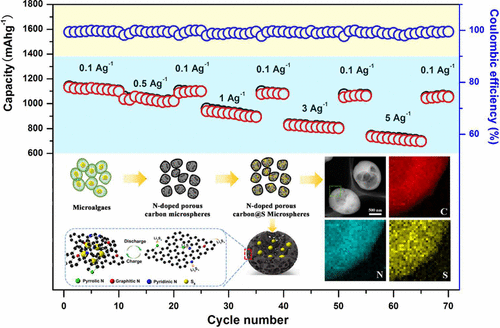当前位置:
X-MOL 学术
›
ACS Appl. Mater. Interfaces
›
论文详情
Our official English website, www.x-mol.net, welcomes your
feedback! (Note: you will need to create a separate account there.)
Confining Sulfur in N-Doped Porous Carbon Microspheres Derived from Microalgaes for Advanced Lithium–Sulfur Batteries
ACS Applied Materials & Interfaces ( IF 8.3 ) Pub Date : 2017-07-07 00:00:00 , DOI: 10.1021/acsami.7b05798
Yang Xia 1 , Ruyi Fang 1 , Zhen Xiao 2 , Hui Huang 1 , Yongping Gan 1 , Rongjun Yan 3 , Xianghong Lu 4 , Chu Liang 1 , Jun Zhang 1 , Xinyong Tao 1 , Wenkui Zhang 1
ACS Applied Materials & Interfaces ( IF 8.3 ) Pub Date : 2017-07-07 00:00:00 , DOI: 10.1021/acsami.7b05798
Yang Xia 1 , Ruyi Fang 1 , Zhen Xiao 2 , Hui Huang 1 , Yongping Gan 1 , Rongjun Yan 3 , Xianghong Lu 4 , Chu Liang 1 , Jun Zhang 1 , Xinyong Tao 1 , Wenkui Zhang 1
Affiliation

|
Lithium–sulfur (Li–S) battery is one of the most attractive candidates for the next-generation energy storage system. However, the intrinsic insulating nature of sulfur and the notorious polysulfide shuttle are the major obstacles, which hinder the commercial application of Li–S battery. Confining sulfur into conductive porous carbon matrices with designed polarized surfaces is regarded as a promising and effective strategy to overcome above issues. Herein, we propose to use microalgaes (Schizochytrium sp.) as low-cost, renewable carbon/nitrogen precursors and biological templates to synthesize N-doped porous carbon microspheres (NPCMs). These rational designed NPCMs can not only render the sulfur-loaded NPCMs (NPCSMs) composites with high electronic conductivity and sulfur content, but also greatly suppress the diffusion of polysulfides by strongly physical and chemical adsorptions. As a result, NPCSMs cathode demonstrates a superior reversible capacity (1030.7 mA h g–1) and remarkable capacity retention (91%) at 0.1 A g–1 after 100 cycles. Even at an extremely high current density of 5 A g–1, NPCSMs still can deliver a satisfactory discharge capacity of 692.3 mAh g–1. This work reveals a sustainable and effective biosynthetic strategy to fabricate N-doped porous carbon matrices for high performance sulfur cathode in Li–S battery, as well as offers a fascinating possibility to rationally design and synthesize novel carbon-based composites.
中文翻译:

将微藻类衍生的N掺杂多孔碳微球中的硫限制在高级锂硫电池中
锂硫(Li–S)电池是下一代储能系统最吸引人的候选之一。然而,硫的固有绝缘性质和臭名昭著的多硫化物梭是主要障碍,这阻碍了Li-S电池的商业应用。将硫限制在具有设计极化表面的导电多孔碳基质中被认为是克服上述问题的一种有前途的有效策略。在此,我们建议使用微藻(Schizochytrium sp。)作为低成本,可再生的碳/氮前体和生物模板来合成N掺杂的多孔碳微球(NPCM)。这些合理设计的NPCMs不仅可以使含硫的NPCMs(NPCSMs)复合材料具有高的电子导电性和硫含量,而且可以通过强烈的物理和化学吸附极大地抑制多硫化物的扩散。结果,NPCSMs阴极在100次循环后在0.1 A g –1的条件下显示出优异的可逆容量(1030.7 mA hg –1)和显着的容量保持率(91%)。即使在5 A g –1的极高电流密度下,NPCSM仍可提供令人满意的692.3 mAh g –1放电容量。。这项工作揭示了可持续和有效的生物合成策略,以制造用于Li-S电池中高性能硫阴极的N掺杂多孔碳基质,并为合理设计和合成新型碳基复合材料提供了一种引人入胜的可能性。
更新日期:2017-07-08
中文翻译:

将微藻类衍生的N掺杂多孔碳微球中的硫限制在高级锂硫电池中
锂硫(Li–S)电池是下一代储能系统最吸引人的候选之一。然而,硫的固有绝缘性质和臭名昭著的多硫化物梭是主要障碍,这阻碍了Li-S电池的商业应用。将硫限制在具有设计极化表面的导电多孔碳基质中被认为是克服上述问题的一种有前途的有效策略。在此,我们建议使用微藻(Schizochytrium sp。)作为低成本,可再生的碳/氮前体和生物模板来合成N掺杂的多孔碳微球(NPCM)。这些合理设计的NPCMs不仅可以使含硫的NPCMs(NPCSMs)复合材料具有高的电子导电性和硫含量,而且可以通过强烈的物理和化学吸附极大地抑制多硫化物的扩散。结果,NPCSMs阴极在100次循环后在0.1 A g –1的条件下显示出优异的可逆容量(1030.7 mA hg –1)和显着的容量保持率(91%)。即使在5 A g –1的极高电流密度下,NPCSM仍可提供令人满意的692.3 mAh g –1放电容量。。这项工作揭示了可持续和有效的生物合成策略,以制造用于Li-S电池中高性能硫阴极的N掺杂多孔碳基质,并为合理设计和合成新型碳基复合材料提供了一种引人入胜的可能性。































 京公网安备 11010802027423号
京公网安备 11010802027423号